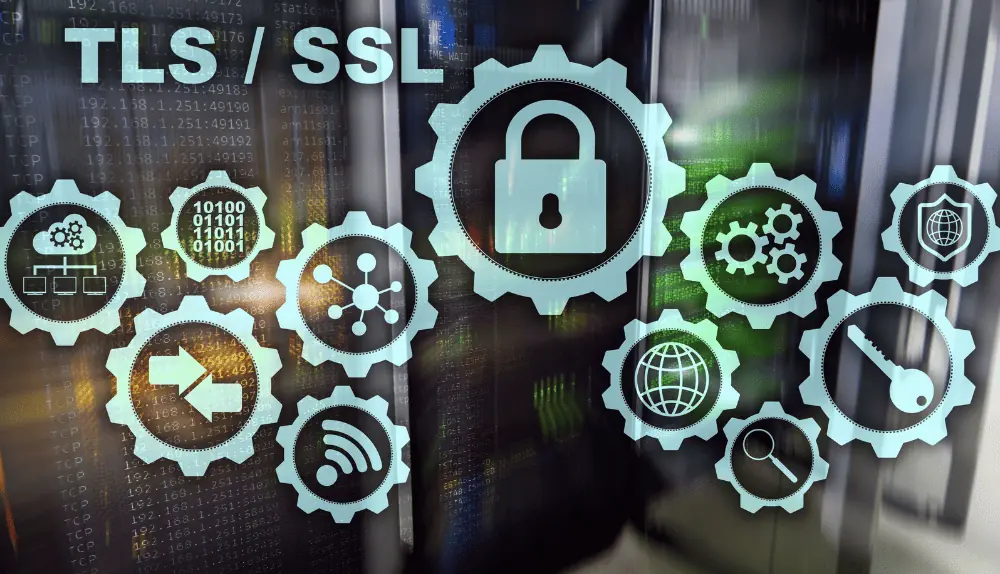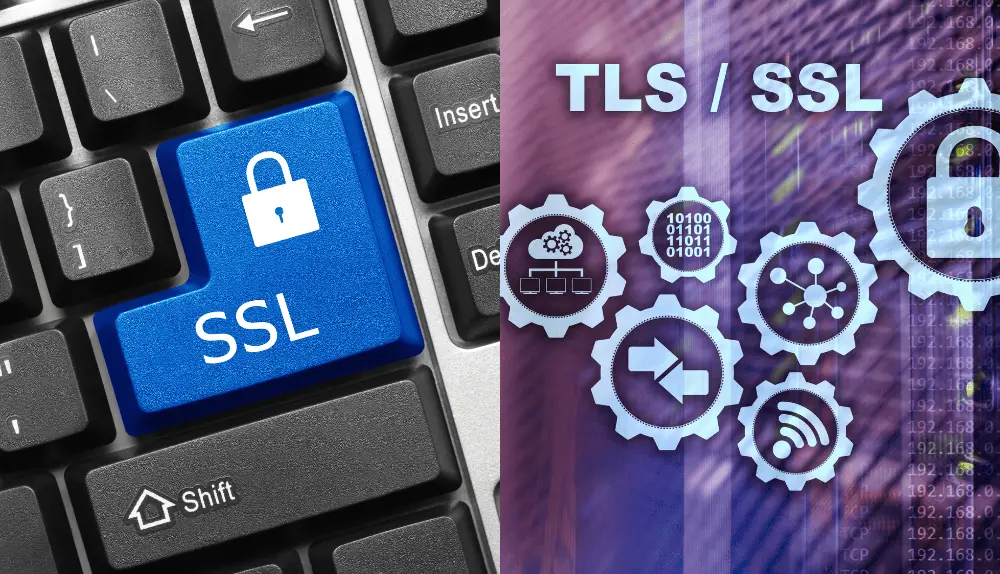In the realm of secure online communication, Transport Layer Security and Secure Sockets Layer (TLS vs SSL) play vital roles in establishing encrypted connections between clients and servers. TLS and SSL are cryptographic protocols that ensure data integrity, confidentiality, and authentication over the Internet. While TLS and SSL are often used interchangeably, there are important distinctions between the two.
This article aims to provide a detailed comparison of TLS and SSL, exploring their historical development, underlying technologies, security features, and practical implications. By understanding the similarities and differences between TLS and SSL, you can make informed decisions about implementing secure communication protocols in various digital environments.
What is TLS?

Transport Layer Security (TLS) is a cryptographic protocol that ensures secure communication between clients and servers over the Internet. It is designed to provide data integrity, confidentiality, and authentication. TLS operates at the transport layer of the TCP/IP protocol suite, establishing a secure channel for data transmission. The primary goal of TLS is to protect sensitive information from snooping, tampering, and unauthorized access.
TLS utilizes a combination of symmetric and asymmetric encryption algorithms to achieve its security objectives. When a client initiates a TLS handshake with a server, they exchange cryptographic keys and negotiate the encryption algorithms and parameters to be used for the session. This negotiation process allows both parties to agree on a common set of encryption methods that provide the highest level of security supported by their systems.
TLS has evolved over the years, with different versions introduced to address vulnerabilities and improve security. The most recent version is TLS 1.3, which offers significant enhancements in terms of performance and security compared to its predecessors.
TLS is widely used for securing various online services, including web browsing, email transmission, file transfer, and virtual private networks (VPNs). Its widespread adoption has made it an essential component of modern internet security, ensuring that sensitive data remains protected during transmission.
What is SSL?

SSL is a cryptographic protocol that is helpful in providing secure communication over the internet. SSL is designed to ensure the integrity, confidentiality, and authenticity of data transferred between clients and servers. It operates at the transport layer of the TCP/IP protocol suite and establishes an encrypted connection between two endpoints.
SSL uses a combination of asymmetric and symmetric encryption algorithms to secure data transmission. During the SSL handshake, the client and server exchange cryptographic keys and negotiate the encryption methods and parameters to be used for the session. This negotiation allows both parties to establish a secure channel through which data can be transmitted securely.
SSL has been widely adopted and implemented in various applications, especially in web browsing. It is commonly used to secure online transactions, like credit card payments and sensitive data transfers, it encrypts the communication between web browsers and web servers. Over time, SSL has undergone several versions, with the latest version being SSL 3.0.
It is worth noting that SSL has been largely superseded by TLS, which is its successor protocol. However, the term “SSL” is still commonly used to represent the TLS and SSL protocols.
Difference Between TLS Vs SSL

Both TLS and SSL are cryptographic protocols that provide secure communication over the internet. While they serve the same purpose, there are several key differences between TLS and SSL. Let’s explore these differences in detail.
Historical Development
SSL was first developed by Netscape Communications in the 1990s to secure online transactions. As SSL evolved, it went through different versions, including SSL 2.0 and SSL 3.0.
TLS was introduced as an upgraded version of SSL to address security vulnerabilities present in SSL 3.0. TLS 1.0 was released in 1999 and has since undergone several revisions, with the latest version being TLS 1.3.
Protocol Architecture
Both TLS and SSL operate at the transport layer of the TCP/IP protocol suite. They establish a secure channel between a client and a server for data transmission. However, TLS and SSL use slightly different cryptographic algorithms and processes for securing communication.
Handshake Process
The handshake process is a crucial step in establishing secure connection between a client and a server. In SSL, the handshake begins with a client sending a “Client Hello” message, followed by a server responding with a “Server Hello” message. This process includes negotiating encryption algorithms, exchanging cryptographic keys, and verifying the server’s digital certificate.
In TLS, the handshake process is similar to SSL, but it has additional features for improved security. TLS includes enhanced cipher suite negotiation, forward secrecy, and support for modern encryption algorithms. The TLS handshake is more secure and efficient compared to SSL.
Security Features
TLS 1.0 and later versions are considered more secure than SSL. TLS incorporates stronger cryptographic algorithms, better key exchange methods, and improved security protocols.
TLS 1.3, the latest version, offers significant security enhancements, including stronger cipher suites, removal of insecure features, improved resistance against attacks, and reduced latency due to optimized handshakes.
Compatibility
SSL and TLS are not fully compatible with each other due to the differences in their protocol versions and encryption algorithms. However, modern systems and applications typically support both protocols, allowing them to negotiate and establish a compatible secure connection.
Usage and Adoption
TLS has gained widespread adoption and has become the standard for secure communication on the internet. Most modern web browsers and servers support TLS. In contrast, SSL has been deprecated and is no longer recommended for use due to security vulnerabilities.
TLS and SSL are cryptographic protocols used to establish secure connections between clients and servers. While SSL was the predecessor of TLS, TLS has evolved to address security flaws present in SSL and has become the standard for secure communication.
TLS offers improved security features, better encryption algorithms, and more efficient handshakes compared to SSL. It is widely adopted and supported by modern systems and applications. If you are implementing secure communication protocols, it is recommended to use TLS instead of SSL due to its enhanced security and compatibility with modern technologies.
Benefits of TLS
TLS offers numerous benefits for secure communication over the internet. Let’s explore some key advantages of implementing TLS in digital environments:
Data Confidentiality
TLS provides encryption of data transferred between clients and servers, ensuring that sensitive information remains confidential. By encrypting data, TLS prevents unauthorized access and eavesdropping, making it significantly more challenging for attackers to intercept and understand the transmitted information.
Data Integrity
TLS uses cryptographic mechanisms, such as digital signatures and hash functions, to verify the integrity of data throughout transmission. This is helpful in ensuring that data remains unchanged and unaltered while in transit. If any modifications or tampering occur during transmission, TLS detects it and alerts the receiving party, ensuring the integrity and reliability of the transmitted data.
Authentication
TLS incorporates a robust authentication process that verifies the identities of both the client and the server. This authentication process involves the use of digital certificates provided by trusted certification authorities (CAs). By validating the server’s digital certificate, TLS enables clients to verify they are connecting to the intended and legitimate server, reducing impersonation or man-in-the-middle attacks risks.
Trustworthiness
TLS relies on a hierarchical system of trusted CAs that issue digital certificates. These certificates contain information about the server’s identity and public key. By using trusted CAs, TLS establishes a chain of trust, ensuring that clients can confidently trust the server’s identity and establish secure connections. This helps to prevent attacks such as phishing or DNS spoofing, where attackers attempt to deceive users by impersonating legitimate websites or services.
Broad Compatibility
TLS is widely supported and implemented across various digital platforms and applications. Major web browsers, email clients, and other network services have built-in support for TLS. This compatibility allows for seamless integration of TLS into existing systems, making it easy to adopt and deploy for secure communication.
Regulatory Compliance
Many industries and organizations are subject to regulatory requirements regarding data privacy and security. Implementing TLS helps to meet these compliance standards by ensuring the secure transmission of sensitive data. For example, PCI DSS mandates the use of TLS for secure online credit card transactions.
Improved Performance
TLS has undergone optimization and efficiency improvements in its later versions. TLS 1.3, in particular, has reduced latency by minimizing the round trips needed during the handshake process. This improved performance enables faster and more efficient secure connections, contributing to a better user experience.
TLS offers significant benefits for secure communication. It ensures data integrity, confidentiality, and authentication while being widely compatible and meeting regulatory requirements. By implementing TLS, organizations can enhance the security of their digital infrastructure, protect sensitive data, and build trust with their clients and users.
Benefits of SSL
SSL provides several benefits for secure communication over the internet. Although SSL has been largely superseded by TLS, it still holds relevance and offers the following advantages:
Data Confidentiality
SSL employs encryption algorithms to encrypt data transferred between clients and servers. This ensures that sensitive information remains confidential and cannot be intercepted or understood by unapproved individuals. SSL encryption provides a strong barrier against eavesdropping and protects data privacy.
Data Integrity
It uses cryptographic mechanisms such as digital signatures and hash functions to ensure the integrity of transmitted data. By verifying data integrity, SSL detects any modifications or tampering that might occur while transmission. This feature ensures that data remains unaltered and reliable, providing assurance to both the sender and receiver.
Authentication
SSL facilitates the authentication of both the client and server. It ensures that clients are connecting to legitimate servers and not falling victim to impersonation or man-in-the-middle attacks. SSL accomplishes this through the use of digital certificates issued by trusted Certification Authorities (CAs). By validating the server’s digital certificate, SSL establishes a trusted connection and enhances trust between the parties involved.
Compatibility
SSL has broad compatibility and is supported by various web browsers, email clients, and network services. This widespread support allows for the seamless integration of SSL into existing systems and applications. Compatibility ensures that users can access SSL-secured websites and services across different platforms, enhancing convenience and accessibility.
Legacy Support
While TLS is the recommended secure protocol for modern systems, SSL is still relevant for legacy systems and applications that have not transitioned to TLS. Many older devices, applications, and embedded systems may only support SSL. In such cases, SSL remains a viable option for ensuring secure communication until an upgrade to TLS is feasible.
Regulatory Compliance
SSL can help organizations meet regulatory requirements related to data security and privacy. For example, compliance standards like the PCI DSS require the use of SSL for securing online credit card transactions. By implementing SSL, businesses can demonstrate compliance with such regulations and protect sensitive customer information.
User Trust
SSL provides a visual indicator to users that a website is secure by displaying a padlock icon and “https://” in the website address. These indicators instill trust in users and reassure them that their data is protected during online transactions and interactions. User trust is vital for building credibility and fostering positive user experiences.
Overall, SSL offers several benefits for secure communication. It ensures data integrity, confidentiality, and authentication while being compatible with various systems and applications. SSL also helps organizations meet regulatory requirements and builds user trust. While TLS is the recommended protocol for modern systems, SSL remains relevant for legacy environments and systems that have not yet transitioned to TLS.
Do You Need SSL/TLS Certificate?
Obtaining an SSL/TLS certificate is essential for implementing secure communication on your website or web application. An SSL/TLS certificate serves as a digital credential that verifies the authenticity and identity of your website or server. It is required to enable HTTPS (Hypertext Transfer Protocol Secure) and establish secure connection between the client’s browser and your server.
Here are some factors why you need an SSL/TLS certificate:
Data Security
An SSL/TLS certificate ensures the data transmission between your website and the user’s browser is encrypted and protected from unauthorized access. This is especially crucial when handling sensitive information like personal details, login credentials, card details, or other confidential data.
User Trust
Users have become more aware of online security risks, and they actively look for indicators of a secure website before sharing sensitive information. An SSL/TLS certificate displays visual cues such as “https://” in the website address, a lock icon, or a green address bar, which signals users that their connection is secure. This helps build trust and credibility with your audience.
SEO Benefits
Search engines prioritize websites with secure connections in their rankings. Having an SSL/TLS certificate and using HTTPS can boost your website’s search engine optimization (SEO) efforts and improve your visibility in search results. This can lead to increased organic traffic and better overall online visibility.
Compliance Requirements
Many industry regulations & standards, such as GDPR, PCI DSS, and Health Insurance Portability and Accountability Act (HIPAA), require the use of SSL/TLS certificates for securing sensitive data. Complying with these regulations is essential for avoiding penalties and maintaining the trust of your customers.
E-commerce and Online Transactions
If you run an e-commerce website or accept online payments, having an SSL/TLS certificate is crucial. It ensures that customer payment information is encrypted and protected during the transaction process, to reduce the risk of data breaches and fraudulent activities.
Mobile App Integration
If your website has a companion mobile application, an SSL/TLS certificate is often required for secure data communication between the app and your server. Mobile platforms, such as iOS and Android, have specific requirements for secure connections, and having an SSL/TLS certificate is essential to meet those requirements.
In summary, an SSL/TLS certificate is necessary to establish secure connections, protect sensitive data, build user trust, comply with regulations, improve SEO, and facilitate secure online transactions. It is an important investment in ensuring the security and credibility of your website or web application.
Should You Use SSL or TLS?
In general, it is recommended to use TLS instead of SSL for securing communication over the internet. TLS is the successor to SSL and offers improved security features and better encryption algorithms. Here are the reasons why TLS is preferred:
Security
TLS has undergone multiple revisions and enhancements to address the security vulnerabilities present in SSL. It offers stronger encryption algorithms and better protection against various attacks, such as man-in-the-middle attacks, cipher suite vulnerabilities, and downgrade attacks. TLS 1.3, the latest version, has implemented significant security improvements and is considered more secure than any version of SSL.
Compatibility
TLS is backward-compatible with SSL. This means that modern systems and applications that support TLS can still establish secure connections with systems that only support SSL. By using TLS, you can ensure compatibility with a wider range of devices, browsers, and services.
Industry Standards and Best Practices
The industry and security communities widely recommend the use of TLS as the standard for secure communication. TLS is the preferred choice for compliance with various regulatory requirements, including PCI DSS (Payment Card Industry Data Security Standard) and HIPAA (Health Insurance Portability and Accountability Act). Following industry standards and best practices helps ensure a higher level of security and demonstrates a commitment to protecting sensitive data.
Ongoing Development and Support
TLS is actively maintained and developed, with new versions and updates released regularly. The TLS protocol benefits from ongoing security research and advancements, leading to continuous improvements in encryption, authentication, and overall security. By using TLS, you can take advantage of the latest security enhancements and stay up-to-date with the evolving security landscape.
While TLS is recommended, there might be certain scenarios where the use of SSL is necessary. For example, if you are working with legacy systems or older devices that only support SSL, you may need to continue using SSL temporarily. However, it is crucial to plan for the transition to TLS as soon as possible to ensure the highest level of security.
Overall, TLS is the preferred choice for secure communication due to its stronger security features, compatibility with modern systems, adherence to industry standards, and ongoing development and support. Implementing TLS ensures a higher level of security and helps protect sensitive data during transmission.
Final Words
In conclusion, when it comes to securing communication over the internet, TLS emerges as the recommended choice over SSL. TLS offers significant advantages, including enhanced security features, improved encryption algorithms, and compatibility with modern systems. It provides data integrity, confidentiality, and authentication, helping to protect sensitive information and build user trust. TLS also aligns with industry standards and compliance requirements, ensuring regulatory compliance and mitigating security risks. While SSL still has relevance for legacy systems, transitioning to TLS is crucial for leveraging the latest security advancements and maintaining a robust security posture. By implementing TLS, organizations can establish secure connections, safeguard sensitive data, and foster a secure and trustworthy digital environment for their users and customers.
Frequently Asked Questions (FAQs)
How does SSL/TLS encryption work?
SSL/TLS encryption works by establishing a secure channel between a client (such as a web browser) and a server. It involves a handshake process where the client and server negotiate encryption algorithms, exchange cryptographic keys, and verify each other’s digital certificates. Once the secure connection is established, data transferred between the client and server is encrypted and protected from unauthorized access.
How can I obtain an SSL/TLS certificate?
To obtain an SSL/TLS certificate, you typically need to go through a certification authority (CA) or a trusted third-party provider. You can purchase a certificate from a commercial CA or obtain a free certificate from organizations like Let’s Encrypt. The process usually involves generating a certificate signing request (CSR), providing necessary information about your organization, and completing a validation process to verify your identity.
Does having an SSL/TLS certificate guarantee my website is secure?
While having an SSL/TLS certificate is an important step in securing your website, it does not guarantee complete security. SSL/TLS primarily secures the communication between the client and server, ensuring data confidentiality and integrity. However, other security measures, such as regular software updates, strong passwords, secure coding practices, and protection against common web vulnerabilities, are also essential to maintain a secure website.
Can I use the same SSL/TLS certificate for multiple domains or subdomains?
Yes, you can use a single SSL/TLS certificate for multiple domains or subdomains through different certificate types. Wildcard certificates secure a main domain and all its subdomains, while multi-domain (SAN) certificates secure multiple distinct domains. These options provide flexibility and cost savings compared to obtaining separate certificates for each domain or subdomain.
What is HTTPS, and why is it important?
HTTPS (Hypertext Transfer Protocol Secure) is the secure version of HTTP, the protocol used for transmitting data over the internet. It incorporates SSL/TLS encryption to ensure secure communication between the client and server. HTTPS is important for protecting sensitive information, like credit card details, login credentials, and personal data, from interception and unauthorized access. It also helps build user trust by displaying visual indicators of secure connection in web browsers.

